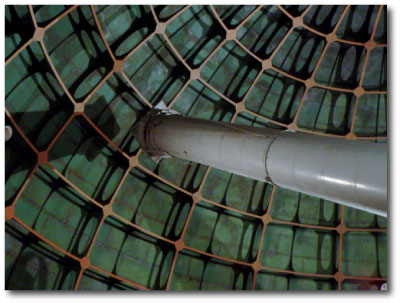
For a theorist, the path of least resistance leads to the abstract. I start to think of planets as signal-to-noise, as peaks on a periodogram. As grant proposals come due, as manuscript drafts bounce back and forth between editors, authors and referees, it’s easy to forget that the planets are really out there, falling endlessly through empty space.
On Monday, we drove up to the Lick Observatory. From the hot rush-hour smog of I-680 in downtown San Jose, the summer-yellow folds of the Diablo range rise out of the hazy valley air. The white telescope domes cling to the highest ridgeline. Exit at Alum Rock. Drive several miles east. The city thins out into suburban sprawl. The Mt. Hamilton Road starts just at the point where the mountains begin to slope up steeply. It takes nearly an hour to cover the 19 miles to the summit, where the observatory buildings sleep mirage-like in the quiet sunlight. Hawks circle against the blue sky. The grasses have dried to straw, and the heat draws the smell of sage and pine resin into the still air.
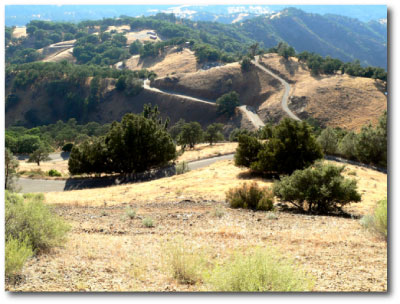
The dome of the Automated Planet Finder is in place now, and the telescope is nearing completion. It’s visible just to the right of the larger three-meter dome in this photo taken from the main observatory building. The Automated Planet Finder will produce long strings of precise radial velocity measurements. Very soon, we’ll be posting synthetic data sets on the systemic back-end that mimic the observational cadences that this telescope will be capable of providing. It will detect some very interesting planets.
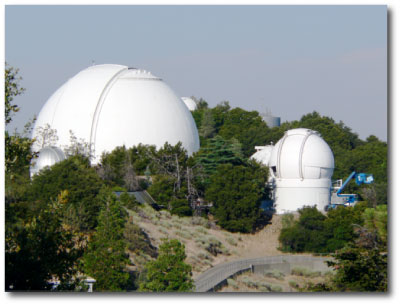
The 36-inch refractor, housed in the great dome of the main building, is still in perfect working order, but it has long since ceded it’s relevance to the cutting-edge. In 1892, E. E. Barnard used it to discover Amalthea, the tiny fifth satellite of Jupiter. This was the last moon in the Solar System to be discovered with the naked eye. More than a century later, the telescope waits silent and unused through most nights. The body of James Lick lies interred at its base. Crickets, lodged in unseen corners of the old building, chirp intermittently in the dark.
Support astronomer Bryant Grigsby brought the great refractor to majestic life. To locate an object on the sky, he repeatedly executed a delicately choreographed sequence of maneuvers. The dome must be rotated so that the slit is positioned on the correct part of the sky. The giant polished and inlaid wood floor must be raised or lowered by up to 16 1/2 feet to bring the eyepiece to eye-level. The 25,000 pound, 57-foot long telescope, perfectly balanced on its pivot, is pulled by hand into rough position, followed by a series of fine adjustments to bring the target into view. The great refractor is priceless. If it’s broken or rendered inoperable, it won’t be replaced. Bryant told me that it took many nights to acquire the confidence to maneuver it on his own.
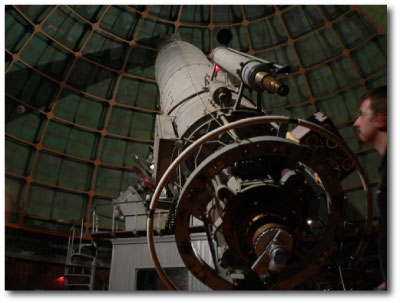
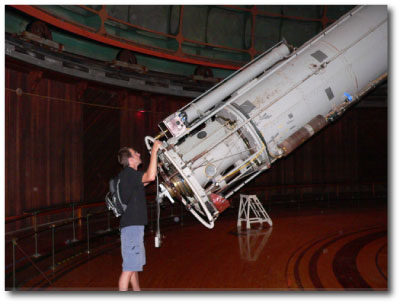
Just before midnight, he swung the telescope low, nearly to its declination limit, and brought Neptune into view. In the high-power eyepiece, it swam, a dim, very pale, bluish-white circle cut out against matte black. Several star-like points were in the field. One of them may have been Triton. Using Illustrator, I’ve tried to capture how it looked.
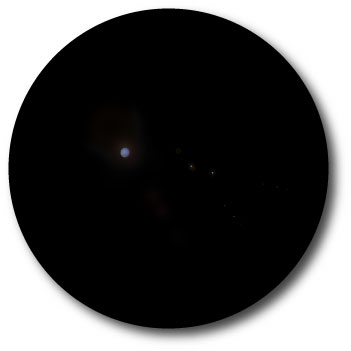
What I can’t fully capture, though, is what it is like to stare, for long unhurried minutes, at a giant frigid world on the fringe of our Solar System, with the crickets chirping in warm dry quiet of the dome, illuminated faintly by the glow of a low-watt red bulb and a window open to the distant twinkling lights of the city grid.

Very interested in your radial velocity work but puzzeled by the huge difference between average magnitude of radial velocity and average magnitude of lateral velocity, for nearby stars that I have plotted from Simbad data.
Have only plotted stars with planets that are within 35pc but it looks to me as if there is a difference between these averages which is in the order of 180 times. Can this be right? Any ideas what I might be doing wrong?
The average radial velocities on the console all have the mean radial space motion of the star subtracted off. The doppler RV method (as generally implemented) just gives relative velocities, and doesn’t determine the absolute radial velocity.
In reality, the velocity dispersion of the stars in the planet surveys is of order 20 km/sec, and is pretty isotropic.
Thankyou for your reply Greg. Have since done a little reading and recognise the problem. Am now looking for a simple RA & Dec conversion factor so that I can relate the FK4 data to the FK5, just roughly, for my home plot.
Does 50sec/yr sound right, along the equator?